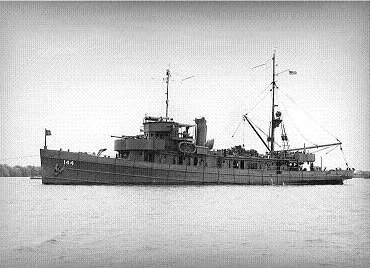![]() The Pacific War Online Encyclopedia
The Pacific War Online Encyclopedia
|
| Previous: Mines Field | Table of Contents | Next: Mingaladon |

Minesweepers are ships equipped to detect and
remove mines. The U.S. Navy
classified dedicated minesweepers as either fleet minesweepers, fast minesweepers, or coastal minesweepers.
Fleet minesweepers were steel-hulled
oceangoing
ships that were often purpose-built as minesweepers. Fast minesweepers
were useful for offensive minesweeping, where
the
minesweeper swept defensive mines
from enemy waters. Coastal minesweepers were small ships, often with
wooden hulls, that were typically converted civilian vessels (often
fishing vessels.)
In addition, ships of other classes often had some minesweeping capability. Many minesweepers were also capable of operating as minelayers.
Minesweeping Methods. There were many types of mines, each requiring different sweeping methods.
Contact
mines
were
swept by
using a very heavy
cable with cutting blades to catch the mooring cables of the mines and
pull
them loose for subsequent destruction by gunfire.The easiest way to
deploy the cutting cable was to stretch it between two ships, but it
was also possible for a single ship to deploy a cable using a paravane.
A paravane was a float equipped with hydrofoils that pulled the float
away from the deploying ship, stretching out the cutting cable behind
it. Whether deployed between ships or by using a paravane, the cable
required "kites" to pull it to the correct depth. These resembled
paravanes, but with controlled hydrofoils to set the cable depth.
Magnetic
mines were best swept
using
a magnetized cable deployed from wooden-hulled
vessels (which did not
trigger the mines.)
A steel-hulled minesweeper (or any other steel-hulled ship) could be
given some measure of protection from magnetic mines using degaussing
cables, which were magnetized cables passed around the hull ofthe ship to neutralize its magnetic field.
Pressure
mines were swept using a towed hulk large
enough to
produce the required pressure surge to activate the mines.
Acoustic
mines could be swept by simulating the screw noises through a
powerful underwater
speaker. However, the Japanese had considerable success sweeping
American acoustic mine fields using "sonobombs", Mark 3 or Mark 4 training noisemakers (hatsuonto). These carried a small charge of Type 88 explosive.
Allied operational researchers worked out various formations for flotillas of minesweepers that maximized sweep coverage while minimizing the danger to the minesweepers themselves. Typically the ships of a minesweeper flotilla would perform the initial sweep using an echelon formation ("G" formation), with the lead ship in deep water outside the danger zone deploying its paravane towards the shore and thereby clearing a safe zone for the second ship, which took up formation behind and towards the beach relative to the lead ship. The second ship likewise deployed its paravane towards the beach, clearing a zone for the third ship, and so on for all the ships in the minesweeper flotilla. Repeated passes were required to thoroughly sanitize an area, with the final sweeps employing a single cable stretched between all the ships of the flotilla ("A" formation) for thoroughness.
A somewhat unconventional system was Two-Speed Destroyer Sweep (TSDS), a form of sweeping gear that could be installed on most British destroyers at short notice. This form of sweep was usable at high speed (up to 25 knots) but was not expected to thoroughly sweep an area. Rather, it was aimed at allowing destroyers rigged with the system to protect the core of a fleet in transit, and it was effective only against contact mines. The chief drawback of TSDS was that its fittings took up significant space on the destroyer's quarterdeck, which was a significant design constraint on British destroyers.
The Japanese had considerable difficulty sweeping the sophisticated mines dropped by the B-29s
in the final months of the war, which combined acoustic, pressure, and
magnetic fuses with counters. It is estimated that they only located
about 30% of the mines that had been dropped by the end of the war, and
it sometimes took up to two months to determine the best way to sweep a
new combination of fuse settings.
References
Minesweepers.org.uk (accessed 2011-2-11)
War Damage Report #58 (1949-1-1; accessed 2011-12-18)
The Pacific War Online Encyclopedia © 2006-2007, 2012, 2014 by Kent G. Budge. Index